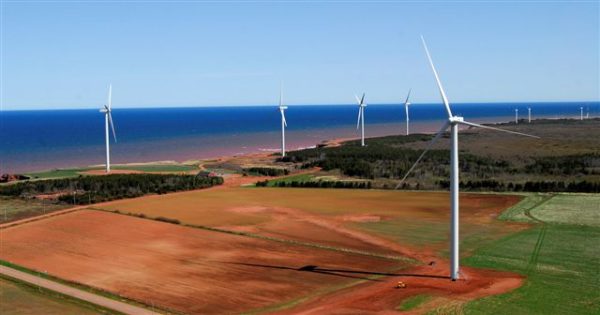Last Thursday, PEI produced more energy from wind generators than the province used

 This past Thursday marked a high point in alternative energy production on Prince Edward Island: the province produced more energy through its wind power generators than it needed. And it’s news like that which will help build momentum in helping environmentalists reach their goal of making PEI the first carbon-neutral province.
This past Thursday marked a high point in alternative energy production on Prince Edward Island: the province produced more energy through its wind power generators than it needed. And it’s news like that which will help build momentum in helping environmentalists reach their goal of making PEI the first carbon-neutral province.
The wind is almost a constant presence on PEI, especially during the stormy months of late fall and winter when gale force winds can down power lines, cancel traffic across the bridge to the mainland and even cause “red-outs” in the middle of summer from all that loose rust-coloured Island soil getting blown around.
The prevalence of windy days is not lost on environmentalists and government officials, either, as witnessed by the eight wind farms currently in operation on PEI. Back in 2008, the province developed a wind energy strategy which set them on a path towards taking advantage of what scientists say is a unique wind regime, unparalleled in much of North America. The average wind speed at the northwest tip of the province is 28.8 km/h, much higher, for instance, than the windiest city in Canada, St. John’s, Newfoundland, which has wind averages of 21.9 km/h.
On Thursday, October 26, the Island generated 105 per cent of its energy needs through wind power, making 164 megawatts when it only used 155. PEI’s output is still small in comparison to provinces like Ontario, the wind energy leader in Canada, which produces over 4,300 MW a year and Quebec, which has generators for 3,260 MW.
But a new energy strategy from PEI’s government is calling for further investment in alternative energy, focusing on both solar construction and wind power. The province is hoping to build two new wind farms, one in 2019 and the other in 2025, and is currently holding talks with Island communities.
“What we’re really just trying to do is gauge the interest in eastern Kings county, see if there is interest in another wind farm there or if there’s no appetite for it at all,” says Kim Horrelt, CEO of the PEI Energy Corporation, which owns and operates four of PEI’s six wind farms. “If not, then that’s fine too and we’ll look at other options.”
Going forward, PEI has a legitimate opportunity to become Canada’s first carbon-neutral province, the subject of a public event held last week by the Institute of Island Studies at the University of Prince Edward Island. The symposium addressed themes on the topic such as community-owned energy utilities, electric-powered vehicles and the energy challenges faced by small islands in the quest to become carbon-neutral.
Speaking at the event was conservation scientist Catherine Potvin of McGill University, who argued that moving to a more energy efficient economy which no longer relies on fossil fuels is not a dream, nor is it necessarily a burden for industry players in places like PEI who currently rely on fossil fuels. “You can make this transition without penalizing farmers,” said Potvin to CBC News.
Below: PEI Rocks Wind Power with highest integration in North America

